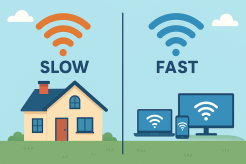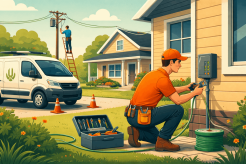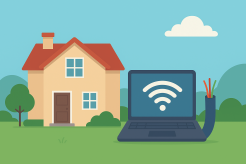What’s the Best Internet Speed for Rural Areas? Finding Fast Options

Reliable internet access is essential in today's digital age, but for those living in rural areas, finding fast and consistent internet can be a challenge. Many factors, such as infrastructure limitations and service availability, affect internet speeds in rural communities. In this guide, we’ll explore the best internet speed options for rural areas and how to choose the right provider based on your needs.
How Much Internet Speed Do You Need?
Before choosing an internet service provider (ISP), it's essential to determine how much speed you need based on your online activities. For example:
Basic browsing and email: 5-10 Mbps
Streaming in HD: 25 Mbps
Online gaming and video calls: 50-100 Mbps
Work-from-home setups and smart homes: 100+ Mbps
If you're unsure how much bandwidth you require, use this internet speed needs tool to estimate your requirements based on your household usage.
Challenges of Finding High-Speed Internet in Rural Areas
Rural areas often struggle with slow or limited internet options due to a lack of broadband infrastructure. Some of the common hurdles include:
Limited availability of fiber-optic or cable services
Higher costs for satellite or fixed wireless connections
Slower speeds compared to urban areas
Because of these challenges, it is crucial to filter internet providers based on speed needs to find the most reliable option in your area.
Fast Internet Options for Rural Areas
Although rural communities may not have access to the same ultra-fast fiber connections as city dwellers, there are still several good alternatives:
1. Fixed Wireless Internet
Fixed wireless internet delivers broadband access via radio signals from a nearby tower. This option provides speeds ranging from 10 Mbps to 100 Mbps, depending on the provider and location.
2. Satellite Internet
Satellite internet is widely available, making it a popular choice for remote areas. However, latency can be an issue for gaming and video conferencing. Services like Starlink are improving satellite speeds significantly.
3. DSL Internet
DSL uses existing phone lines to provide internet service. While speeds are typically slower (10-50 Mbps), it remains a dependable option where cable or fiber is unavailable.
4. Fiber Internet (Where Available)
In some rural areas, fiber-optic internet is expanding, offering speeds up to 1 Gbps. If you have access to fiber, it's one of the best choices for speed and reliability.
To find the fastest available options near you, check out the fastest internet providers and see who offers the best speeds in your location.
Final Thoughts
Choosing the best internet speed for rural areas requires careful consideration of your needs and available options. Whether you opt for fixed wireless, satellite, DSL, or fiber, ensuring you have enough speed for your daily activities is crucial. By using tools to evaluate your speed requirements and filtering providers based on availability, you can find the best internet solution for your rural home or business.
Are you currently searching for faster internet in a rural area? Let us know your experiences in the comments below!
Related Posts

Wed, Dec 17, 2025 2:22 AM
WifiWhy’s My Internet Slower Than What I’m Paying For?
Paying for fast internet but getting slow speeds? Learn the real reasons your internet doesn’t match your plan and how to fix performance issues.

Wed, Dec 17, 2025 1:55 AM
TechnologyDisney Plus: Shows, Plans & Must-Watch Picks
Discover Disney Plus features, subscription plans, and what to watch. Learn why Disney Plus is worth it for families, Marvel fans, and Star Wars enthusiasts.

Tue, Dec 16, 2025 2:05 AM
Internet BundlesBest Home Wi‑Fi and Internet Providers in the U.S. (Updated)
Compare the best home Wi‑Fi and internet providers in the U.S., including up‑to‑date pricing, speeds, and coverage for Xfinity, Verizon Fios, AT&T Fiber, CenturyLink, and satellite options.

Tue, Dec 16, 2025 12:26 AM
Broadband InstallationGetting Windstream Fiber Set Up: What the Installation Really Looks Like
Learn what to expect from Windstream fiber installation, from preparation to setup, costs, and optimization tips for faster internet.

Mon, Dec 15, 2025 2:24 AM
Internet Bundles Broadband DealsFrontier Internet Review: Affordable Fiber and DSL
An updated Frontier Internet review covering fiber and DSL plans, current pricing, speeds, fees, and availability. See whether Frontier is worth it for your home.